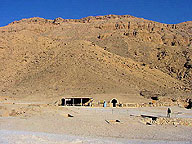 |
Nefertari
Merytmut ("Beautiful Companion, Beloved of Mut")
was born about 1302 BC. There continues to be (and may
always be) controversy about her origins. She may be a
daughter of Seti I (and thus the sister or half-sister of
her future husband), or possibly the granddaughter of
Pharaoh Ay of the 18th Dynasty, or her designation as 'hereditary
princess' has led to speculation that she may have been
the daughter of a Theban nobleman, thus securing the
unity and good relations of the Northern Kingdom [Nile
Delta] from whence the 19th Dynasty came, and the
Southern Kingdom, with Thebes as its capitol. In any case,
at age 13 she married the Prince Regent of Egypt,
Ramesses, then himself a boy of 15. Ten years later
Pharaoh Seti I died, and Ramesses II (aka Ramesses the
Great) became Pharaoh of Upper and Lower Egypt. Nefertari
bore Ramesses at least four sons and two daughters in her
role as Great Royal Wife, but none of her sons outlived
their father. When Ramesses II died in 1213 at age 91,
Merneptah, the 13th son (by Isotnofret) became pharaoh.
Nefertari died in 1246, at age 56, of unknown cause and
was buried in the Valley of the Queens near Thebes.
|
 |